By Mary Reddy with Pat Reddy
Editor's Note: The Lorian Association, as spiritual community, is nonpartisan, but our writers and readers come from diverse social and political backgrounds. With the nation so divided and the future on nearly everyone's minds, it's inevitable that some of our blog posts may reflect certain political leanings. Always our goal is to promote an Incarnational viewpoint. In the upcoming weeks we will be publishing blog posts from both liberal and conservative perspectives that offer insight into how real people in our nation are coming together and bridging divisions, even and especially the ones within themselves.
On election night, when it became obvious that Trump would win, my body slammed into fight-or-flight mode. Adrenaline pumping high, stomach twisting—it took me long hours to physically calm down. I knew right away that I’d fallen into my childhood response of shunting strong emotion into my somatic field before I could even begin to feel it. Perhaps this served me well when I was very young. But as an adult, I’ve worked on opening to my emotions, because I understand how they serve me. I understand that they will not kill me or anyone else.
But sometimes the old pattern switches into gear before I can stop it. And I had one of those nights. As I lay sleepless, trying to soothe my body’s frenetic pulsing with measured breathing, I began to feel my emotions. They crept out of hiding. And they brought with them a great longing to be with people I love. Being together with loved ones felt like the most important thing to do in the face of fear and loss.
When the sun rose the next day, I spoke with people by email and by phone. My brother Pat sent me an email in which he wrote so beautifully about where he stood, that I asked his permission to share it more broadly.
 “We still have power, individually and collectively, to shape and respond to our present and future. I look outside my window now and wonder if I will still be in this wonderful place in 2 years. There are so many aspects of our future, once seemingly stable, that we feel are up for grabs right now. The list seems endless, and our minds and hearts do what they are supposed to do in these circumstances. We freak out and look for an exit, but there does not seem to be one.
“We still have power, individually and collectively, to shape and respond to our present and future. I look outside my window now and wonder if I will still be in this wonderful place in 2 years. There are so many aspects of our future, once seemingly stable, that we feel are up for grabs right now. The list seems endless, and our minds and hearts do what they are supposed to do in these circumstances. We freak out and look for an exit, but there does not seem to be one.
We have power, the power to dance with our own emotions and to dance with whatever the future brings. We have deep power. In my quiet space I will let my terror and revulsion, hopes and fears, dreams and gratitude flow into my consciousness without judgement or any attempts to control them. If this is a disaster, it will play out in slow motion, and fight or flight impulses will not be what get us through. When the dust settles in my psyche, I will look for that collective resilience that is part of our common nature. We cannot individually control what will happen. We each can go through our grieving processes and heal internally. Then it will be clearer to us how we should act. We will be able to let go of whatever it is we need to let go of. We will be able to choose whatever new thing it is we are meant to choose. Self care and at some point working together with all who share this connection to what is good and true will give us the power to dance with whatever comes.
All I can do right now is surrender to this process. I am willing to not think of things I cannot control or join with others to fight them, whichever ultimately makes sense. I am willing to jettison aspects of my life or my expectations for my life or fight to keep them, whichever ultimately makes sense. I did not choose a future with Trump, and I will not let him defeat my spirit, but this morning I feel the terror that has gripped millions. An uninformed and fearful portion of the country has made a choice that puts all of us in jeopardy. I will not hand over my joy and hope to their fears. These are mine now, and I will do whatever I can to share them with those I love and those in need. I will do whatever I can to receive wisdom and strength from others. I will wait for those deep inner powers and faculties, deep in our souls where all things are connected. I must wait for them to console me, to show me my reality, and to take over the dancing when the shock and grief have subsided. These inner realities are much bigger than what just happened to us and more omnipresent. Our lives belong to us."
Karla McLaren, in The Language of Emotions, writes about the great gifts our emotions offer us, if we wisely honor them and allow them to flow through us—especially the so-called negative emotions. Fear alerts us to focus our attention on our environment. Anger energizes us to firm up our boundaries or move into right action. Grief allows us to release, to let go, in the face of loss. Weeks after the election, I am once more feeling my feelings. And in that alive state, I am reunited with fiery hope. This is my life, your life. We are here together. Oh, the things we can do!
Views from the Lorian Community publishes essays from a team of volunteer writers expressing individual experiences of a long term, committed practice of Incarnational Spirituality (and the general principles shaping such a practice.) Views expressed do not necessarily reflect the sentiments or thoughts of any other person in Lorian or of Lorian as a whole. If you would like to subscribe, please visit our website and click on Follow Our Blog Via Email. Or email the editor:drenag@lorian.org.


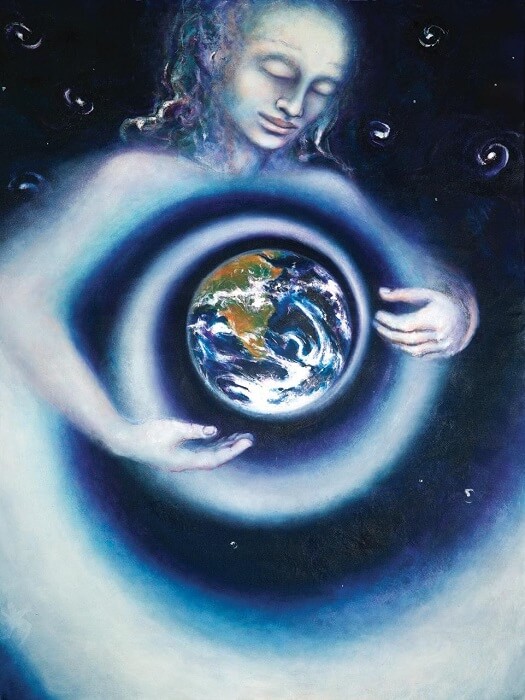
 Having been blessed with some acute senses, I move through a world brimming with sights, sounds and smells. Given that I share that world with a partner who has no sense of smell and is partly deaf, I am especially aware of how much I depend on these senses. Last week my dependence on my nose was brought uncomfortably to my attention.
Having been blessed with some acute senses, I move through a world brimming with sights, sounds and smells. Given that I share that world with a partner who has no sense of smell and is partly deaf, I am especially aware of how much I depend on these senses. Last week my dependence on my nose was brought uncomfortably to my attention. When I got to the checkout lines, there were three to choose from, one of which would take me right behind this woman. Noticing her felt uncomfortable. Do I hide from her and let this discomfort continue? It seemed as if she was studiously avoiding seeing me. I decided that I would push through my embarrassment and reach out to my neighbor, perhaps alleviating her probable discomfort at the same time. I pulled into line behind her and touching her gently on the shoulder, getting her attention, I said, "You are right. People might not appreciate my nose in the bags. Thank you for pointing it out to me."
When I got to the checkout lines, there were three to choose from, one of which would take me right behind this woman. Noticing her felt uncomfortable. Do I hide from her and let this discomfort continue? It seemed as if she was studiously avoiding seeing me. I decided that I would push through my embarrassment and reach out to my neighbor, perhaps alleviating her probable discomfort at the same time. I pulled into line behind her and touching her gently on the shoulder, getting her attention, I said, "You are right. People might not appreciate my nose in the bags. Thank you for pointing it out to me." Would you like an opportunity to deepen your capacity to meet daily moments of choice with an attitude of wholeness, love and blessing? Would you welcome the chance to develop your practice of subtle activism with others of like heart and mind? From December 4-10, join us for
Would you like an opportunity to deepen your capacity to meet daily moments of choice with an attitude of wholeness, love and blessing? Would you welcome the chance to develop your practice of subtle activism with others of like heart and mind? From December 4-10, join us for 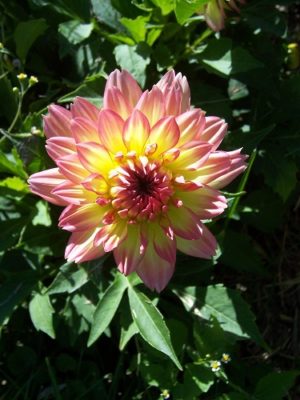 Word of the first frost reminds me of the dahlias. It's another sort of news, I think, as I start the coffee. Dahlias have been the major headline in the garden for over a month. Yellow blossoms the size of dinner plates, orange fireworks, purple pom-poms, and my favorites, the smallish sun-set beauties with pink-gold-scarlet petals. And now what? They always go black overnight beneath the touch of the first frost—all of them, all at once. It happens every year and is a powerful and dramatic moment. I often can’t remember, as I look at the charred remains the next morning, which was which. Was this shriveled plant tall or medium-tall? Was its flowering occasional or prolific? What color were the flowers? All individuality wiped out in one shot.
Word of the first frost reminds me of the dahlias. It's another sort of news, I think, as I start the coffee. Dahlias have been the major headline in the garden for over a month. Yellow blossoms the size of dinner plates, orange fireworks, purple pom-poms, and my favorites, the smallish sun-set beauties with pink-gold-scarlet petals. And now what? They always go black overnight beneath the touch of the first frost—all of them, all at once. It happens every year and is a powerful and dramatic moment. I often can’t remember, as I look at the charred remains the next morning, which was which. Was this shriveled plant tall or medium-tall? Was its flowering occasional or prolific? What color were the flowers? All individuality wiped out in one shot.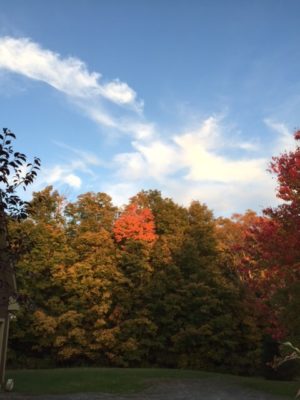 On my way down the drive, with the dog excitedly checking out every scent on every leaf and blade of grass, an early shaft of sun light pulls my eyes upwards to a circle of orange within one of the maples. Amazing! An orange circle within the lingering summer green of one tree shouting, “Make a joyful noise unto the Lord, all ye lands…”
On my way down the drive, with the dog excitedly checking out every scent on every leaf and blade of grass, an early shaft of sun light pulls my eyes upwards to a circle of orange within one of the maples. Amazing! An orange circle within the lingering summer green of one tree shouting, “Make a joyful noise unto the Lord, all ye lands…” 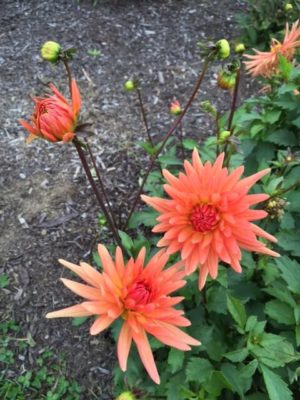 Ten minutes later I’m back in the kitchen with a pocketful of nasturtiums seeds (the bumpy bead-like shapes), one last enormous bouquet of dahlias (pick them all when you can!) and the folded newspaper under my arm. The coffee’s ready. And I’m actually already all filled up. Filled up with the local, all-around-me, find-what-you can news. The news that makes me glad and excited to be here.
Ten minutes later I’m back in the kitchen with a pocketful of nasturtiums seeds (the bumpy bead-like shapes), one last enormous bouquet of dahlias (pick them all when you can!) and the folded newspaper under my arm. The coffee’s ready. And I’m actually already all filled up. Filled up with the local, all-around-me, find-what-you can news. The news that makes me glad and excited to be here. I was born into a great experiment in individual freedom—the United States—founded on the values of life, liberty, and the pursuit of happiness. Experiments exist to test what’s possible and this one asked, “What can bring a vast multicultural and multiracial population into a life of shared governance and mutual respect?” One does not experiment where everything is already known, where the solution has been found. My country’s democracy did not begin as a perfect realization of the ideal. The government stole land from native tribes. It reserved individual rights for some while excluding others. Over decades and after valiant struggles, the democracy opened wider to include women and former slaves. But the push continues for a just society, with full participation and equal access for all.
I was born into a great experiment in individual freedom—the United States—founded on the values of life, liberty, and the pursuit of happiness. Experiments exist to test what’s possible and this one asked, “What can bring a vast multicultural and multiracial population into a life of shared governance and mutual respect?” One does not experiment where everything is already known, where the solution has been found. My country’s democracy did not begin as a perfect realization of the ideal. The government stole land from native tribes. It reserved individual rights for some while excluding others. Over decades and after valiant struggles, the democracy opened wider to include women and former slaves. But the push continues for a just society, with full participation and equal access for all.  In a recent Views from the Borderland, David quoted one of his subtle colleagues saying that we incarnate humans “have a sense of organizations but not of organisms, thus it’s hard for us to understand and appreciate the sphere of interconnectedness and wholeness in which souls normally function.” We “project onto the subtle worlds … images of hierarchy, rank, status, and specialness.”
In a recent Views from the Borderland, David quoted one of his subtle colleagues saying that we incarnate humans “have a sense of organizations but not of organisms, thus it’s hard for us to understand and appreciate the sphere of interconnectedness and wholeness in which souls normally function.” We “project onto the subtle worlds … images of hierarchy, rank, status, and specialness.”  Manifestation is often seen as a way of getting something. But from the perspective of Incarnational Spirituality, it’s an act of identity, of becoming something. It’s an act of ‘incarnating’ a new pattern of ourselves into reality, and growing into a new expression of ourselves. Join us on Sunday, October 16, for a Free Teleclass on using the principles of Incarnational Manifestation to shape a life you love.
Manifestation is often seen as a way of getting something. But from the perspective of Incarnational Spirituality, it’s an act of identity, of becoming something. It’s an act of ‘incarnating’ a new pattern of ourselves into reality, and growing into a new expression of ourselves. Join us on Sunday, October 16, for a Free Teleclass on using the principles of Incarnational Manifestation to shape a life you love.  About a month ago my husband Ed and I were driving down the main street of Greenfield (a nearby town) around 4:30 pm. I was at the wheel, going about 20 MPH, there were no cars close behind us, we were on our way back from a 9 hour road trip to Boston, and were eager to get home.
About a month ago my husband Ed and I were driving down the main street of Greenfield (a nearby town) around 4:30 pm. I was at the wheel, going about 20 MPH, there were no cars close behind us, we were on our way back from a 9 hour road trip to Boston, and were eager to get home. Yet from the look on Cliff’s face I knew he was asking for more than that. I looked again at his drawing, more intently this time, saw there was an unclear spot and saw too how it might be rectified. When I pointed out my suggestion, his face lit up. This was a five minute exchange yet, within those few minutes, I knew my response to be an acknowledgement of relationship, not just between two people but between two people and a world of possibilities—as they were being revealed in an art class. This was response at it’s most hopeful and joyful.
Yet from the look on Cliff’s face I knew he was asking for more than that. I looked again at his drawing, more intently this time, saw there was an unclear spot and saw too how it might be rectified. When I pointed out my suggestion, his face lit up. This was a five minute exchange yet, within those few minutes, I knew my response to be an acknowledgement of relationship, not just between two people but between two people and a world of possibilities—as they were being revealed in an art class. This was response at it’s most hopeful and joyful. 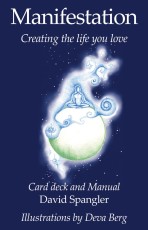
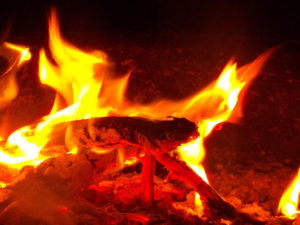 Imagine that you are camping in the woods. You are in a clearing at the center of which is a fire pit. In the forest around you, you see plenty of dry kindling and pieces of wood that you can use to build a fire and keep it going.
Imagine that you are camping in the woods. You are in a clearing at the center of which is a fire pit. In the forest around you, you see plenty of dry kindling and pieces of wood that you can use to build a fire and keep it going.
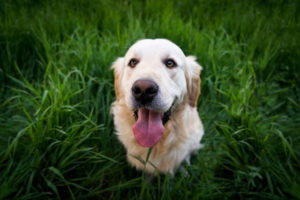 One evening last month, it was clear my mother's golden retriever, Winston, was dying. I could see in my Mom's face the same devastation I feel whenever one of my own dogs has died. She was going to have him put to sleep the next morning. Saying goodbye to a beloved animal companion is utterly heartbreaking, every single time.
One evening last month, it was clear my mother's golden retriever, Winston, was dying. I could see in my Mom's face the same devastation I feel whenever one of my own dogs has died. She was going to have him put to sleep the next morning. Saying goodbye to a beloved animal companion is utterly heartbreaking, every single time.  If our hearts have Achille's heels, mine is animal suffering. The dog meat festival hit me where I am most vulnerable, triggering all of my worst fears and greatest sorrows about humanity’s relationship with animals. Dogs were the very first animal be domesticated, throwing their lot in with ours over 15,000 years ago. Perhaps because they have allied themselves completely with humanity, loving and serving us since we sat in skins around campfires, the deliberate abuse of dogs seems the worst form of betrayal.
If our hearts have Achille's heels, mine is animal suffering. The dog meat festival hit me where I am most vulnerable, triggering all of my worst fears and greatest sorrows about humanity’s relationship with animals. Dogs were the very first animal be domesticated, throwing their lot in with ours over 15,000 years ago. Perhaps because they have allied themselves completely with humanity, loving and serving us since we sat in skins around campfires, the deliberate abuse of dogs seems the worst form of betrayal. 
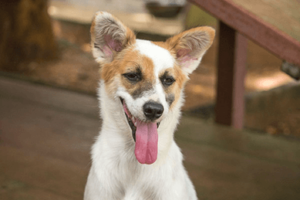
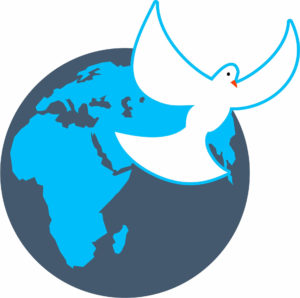 It is very apparent that we are passing through a difficult time together on planet Earth. There is a growing recognition that our conventional social, economic, and political systems are no longer working well enough (if they ever did) to bring about a just, sustainable, and spiritually fulfilling world. However, while many responsible voices have identified the need for a fundamental evolutionary shift, other forces are exploiting this climate of discontent for their own ends.
It is very apparent that we are passing through a difficult time together on planet Earth. There is a growing recognition that our conventional social, economic, and political systems are no longer working well enough (if they ever did) to bring about a just, sustainable, and spiritually fulfilling world. However, while many responsible voices have identified the need for a fundamental evolutionary shift, other forces are exploiting this climate of discontent for their own ends.


 How do we use the principles of Incarnational Spirituality to engage these turbulent social and political times?From October 2-8 join Lorian Facilitators David Spangler and James Tousignant for
How do we use the principles of Incarnational Spirituality to engage these turbulent social and political times?From October 2-8 join Lorian Facilitators David Spangler and James Tousignant for